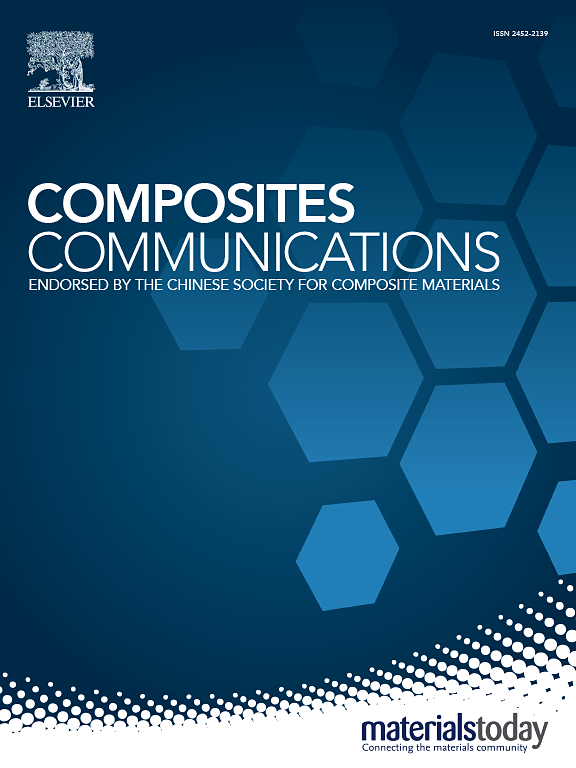Topologically reconfigurable polypropylene composites: Boronic ester crosslinking for concurrent mechanical reinforcement and circular reprocessability
IF 7.7
2区 材料科学
Q1 MATERIALS SCIENCE, COMPOSITES
引用次数: 0
Abstract
Environmental pressures on polypropylene are intensifying, yet its current recycling rates remain alarmingly low. The primary challenges lie in the high costs of recycling and the limited value of its reuse. In this work, we present a straightforward and feasible approach to construct dynamic crosslinking structures within polypropylene, enabling its efficient recycling. The dynamic boronic ester-based crosslinked polymers (PGCs) with excellent mechanical properties and recyclability are successfully developed by thermally initiated ring-opening reaction between glycidyl methacrylate-modified polypropylene (PP-g-GMA) and 4-carboxyphenylboronic acid pinacol ester (CAPE). PGC2 exhibits the most optimal thermal and mechanical properties with the Tg, tensile strength, and elongation at break of 20.4 °C, 33.7 MPa, and 55.8 %, respectively. Subsequently, the dynamic crosslinking system is introduced into the PP matrix to evaluate the mechanical properties of the composites. The boronic ester bonds promote the topological rearrangement of the network through ester exchange reaction, endowing the PP composites with good reprocessability. It retains tensile strength and elongation at break comparable to those of the pristine sample after two reprocessing cycles. This dynamic crosslinking mechanism provides innovative ideas for the development of low-cost and high-value recycled plastics.
拓扑可重构聚丙烯复合材料:硼酯交联并发机械增强和循环再加工性
聚丙烯面临的环境压力正在加剧,但其目前的回收率仍然低得惊人。主要的挑战在于回收的高成本和再利用的有限价值。在这项工作中,我们提出了一种简单可行的方法来构建聚丙烯内部的动态交联结构,使其能够有效地回收。通过甲基丙烯酸甘油酯改性聚丙烯(PP-g-GMA)与4-羧基苯基硼酸蒎醇酯(CAPE)的热引发开环反应,成功制备了力学性能优良、可循环利用的动态硼酯基交联聚合物(PGCs)。PGC2的热力学性能最佳,Tg、抗拉强度和断裂伸长率分别为20.4℃、33.7 MPa和55.8%。随后,将动态交联体系引入到PP基体中,评价了复合材料的力学性能。硼酯键通过酯交换反应促进网络的拓扑重排,使PP复合材料具有良好的再加工性。它保留了抗拉强度和断裂伸长率,可与经过两次再处理循环的原始样品相媲美。这种动态交联机制为低成本、高价值再生塑料的开发提供了创新思路。
本文章由计算机程序翻译,如有差异,请以英文原文为准。
求助全文
约1分钟内获得全文
求助全文
来源期刊

Composites Communications
Materials Science-Ceramics and Composites
CiteScore
12.10
自引率
10.00%
发文量
340
审稿时长
36 days
期刊介绍:
Composites Communications (Compos. Commun.) is a peer-reviewed journal publishing short communications and letters on the latest advances in composites science and technology. With a rapid review and publication process, its goal is to disseminate new knowledge promptly within the composites community. The journal welcomes manuscripts presenting creative concepts and new findings in design, state-of-the-art approaches in processing, synthesis, characterization, and mechanics modeling. In addition to traditional fiber-/particulate-reinforced engineering composites, it encourages submissions on composites with exceptional physical, mechanical, and fracture properties, as well as those with unique functions and significant application potential. This includes biomimetic and bio-inspired composites for biomedical applications, functional nano-composites for thermal management and energy applications, and composites designed for extreme service environments.
 求助内容:
求助内容: 应助结果提醒方式:
应助结果提醒方式:


